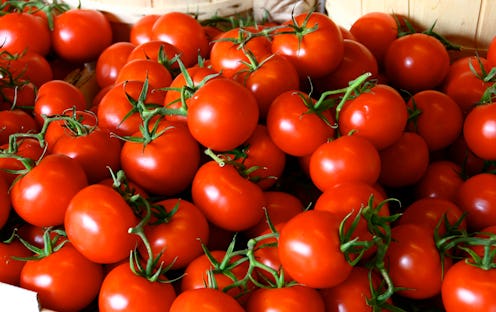
If there is one thing I can count on every summer in New Hampshire, it's the inexcusable amount of organic tomatoes being offered to me. Perhaps it's due to the inexpensive cost of tomato seeds or maybe it's the fact that tomatoes are so easy to grow that even I — someone who has killed a cactus, a goldfish, and all the time I thought I had to write a novel this summer — can grow tomatoes. Each year, my mother is one of the biggest culprits of growing way too many tomatoes for one family. She's offered tomatoes to her co-workers, her pharmacist, our plumber, and I'm sure if she wasn't so busy cultivating said tomatoes, she would find time to ship them across the country.
This year, I knew immediately what I would do with all those tomatoes that she inevitably snuck in my rental car. My face was less than desirable this past August, so my pimples became public enemy number one. I knew that tomato juice is good for acne, both treating AND preventing it. When I unloaded my car this year to find tomatoes and a Post-it with a smile, my roommate and I didn't need to make pounds of salsa or drink ourselves into a homemade Bloody Mary stupor. Instead we used them all over our face.
You probably already know this super food is incredibly healthy for our internal bods: Tomatoes are known to prevent cancer, lower cholesterol, and restore pH levels. These plump fruits are also packed with vitamins A, B, C, and K which are vitamins the skin loses throughout the day. The antioxidant, lycopene, is what sources say makes this food prevent cancer; that same antioxidant is powerful enough to ward of free radicals which often lead to increased oil build-up, acne, and skin irritation.
Your face, just like your body, should run slightly alkaline. The pH scale ranges from 0-14 with 0 being the most acidic and 14 being the most alkaline. According to numerous sources, Livestrong included, a common cause of acne and oily skin is using any product (OTC or natural) with a highly acidic pH level. Tomatoes are a great way to balance our skin, our hair, and our bodies. Ever wonder why your hair sometimes seems lighter or darker? Discoloration of hair is a common cause of highly acidic hair. Tomatoes have a pH level of about 3.5 and 4.5, putting them on the acidic side, but put those ripe tomatoes on your skin or in your hair and they alkalize and provide the perfect beauty balance.
Try these recipes balance your skin struggles and treat your hair battles!
1. Soothe A Rash
There are many causes of skin rashes that range from contact dermatitis, where your skin simply has a reaction to something you've touched, to situations as serious as shingles. You should always consult a physician about the color, texture, and location of a rash to make sure there isn't a deeper issue before doing any DIY treatment. Those of us with allergies have become pros at figuring out that a natural remedy can be quicker and just as efficient as running to the pharmacy. Apply honey and tomato juice on site and leave on for several minutes. You should notice a reduction in the size of bumps and overall inflammation.
2. Treat Blackheads
A ripened, sliced tomato can be your ticket to finally ditching those pesky pore strips. One of the most common reasons pores are clogged in the first place is an overproduction of oil. Tomatoes can naturally control sebum production and unclog those pores without the pain of strips. Just mix fresh squeezed tomato juice (including the pulp but excluding the seeds, if possible) with fresh lemon juice and apply directly ON the blackheads. If you suffer from chronic blackheads, remove the harsh lemon from the recipe and use for a daily blackhead prevention treatment.
3. Cleanse Naturally
This is an awesome cleanser for highly acidic skin in need of a natural balance. Personally, I love using this mask when my skin starts getting those familiar tiny bumps that don't quite seem to become pimples. I mix fresh tomato juice with baking soda to form a thick, wet paste. Keep this mask on your skin until it becomes completely dry and then rinse off. Use this cleanser up to three times a week. If you already use baking soda on your skin daily — it can be drying on dry to normal skin, but works wonders for oily — you can use this as a nightly cleanser.
Image: liz west, postbear eatersoftheworld, cool.as.a.cucumber/Flickr; Kristin Collins Jackson